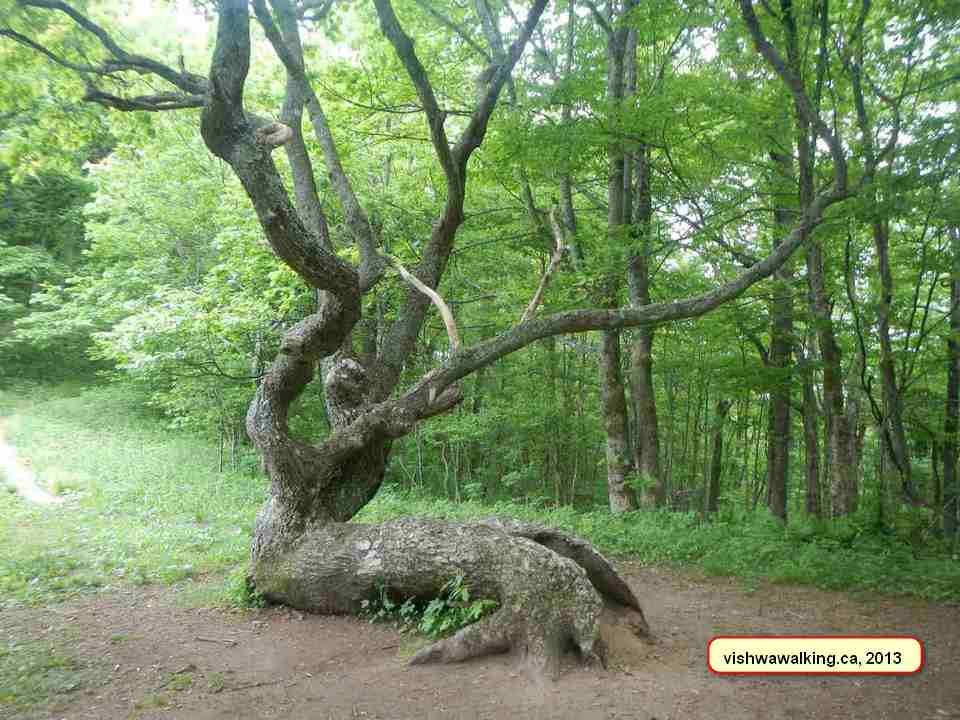About Us
Vishwawalking explained
 Ratings Explained
Ratings ExplainedVishwawalks
Parks, etc.
Funky Places
Future walks
Food
Gear and Health
Get Lost
Good reads
Links
Plants - Animals
Right to Ramble
Site map
Contact us
Vishwawalking
The Appalachian TrailHistory
The
Appalachians were formed more than 480 million years ago. They were
once as grand as the Rockies, but have now eroded to their present
state. From the north, the Appalachians start somewhere around
Newfoundland and extend to Alabama.
In 1528, Spanish explorer Alvar Nunez Cabeza de Vaca came upon a native town in present-day Florida. They transliterated the native name into "Appalachen." A lake, a river and eventually a set of mountains took on the name, and eventually the whole range became known as the Appalachian Mountains. Most people say "a-puh-LATE-chun" today but the original was "a-puh-LATCH-un" (a short "a"), which some southern Americans still use. It could arguably be said to be the "correct" pronunciation, although correct is a thorny subject when it comes to language.
I like the story of how Appalachan Trail official founder Benton MacKaye, developed a journal at the age of fourteen. MaKaye aspired to catalogue the whole world, starting and ending in his home town. This resonates with me. I call my hometown "corpus mundi" and I have many "vishwawalks" that radiate from its centre. In my mind, they wrap around the globe.
MaKaye was born in 1896. In 1921, he laid out a plan for the tract of land between Maine and Georgia in which the trail was not the major focus. He wanted it to contain rural centres of recreation and recuperation especially for urban people. In 1925, after a short section of the trail opened, Mackaye organized the first conference to discuss his ideas. It ultimately focused less on his idealistic vision and more on actually developing the trail and acquiring land for it.
The trail attracted supporters who gradually were able to open sections. In 1937, the trail was completed. Today it passes through 14 states: Georgia, North Carolina, Tennessee, Virginia, West Virginia, Maryland, Pennsylvania, New Jersey, New York, Connecticut, Massachusetts, Vermont, New Hampshire, and Maine. The trail has ubndergone extensive changes since its creation.
In the United States, the Appalachian is one of three long trails known as the Triple Crown of Hiking. The other two trails are the Pacific Crest Trail and the Continental Divide Trail.
Resources used for this article:
Humanities: The Magazine of the National Endowment For the Humanities. This article gives a nice overview of the life of Benton MacKaye and his dream of the trail.
Wikipedia has a good general overview, with a short breakdown of the trail in every state, a good history of the trail, an outline of the lore involve for thru-hikers and section hikers and a section on flora and fauna.
To this day, trail supporters fight off attempts to develop it or to use its land or to burrow underneath it. This 2020 article discusses pipeline issues in West Virginia and North Carolina. Of course, sometimes pipelines and trail supporters find ways to work together (sort of).
Not everyone loves the Appalachian trail, or at least its perceived strongarm techniques to get land. In a contry that is besotted by ownership, this is a big problem. I heard a number of stories about enraged landowners being pushed off the land, especially poor landowners. Here is one view of land purchases that the writer believes is not fair to landowners.
The New World Encyclopedia has a good description of the mountains, the trail and the general geology of the area. It's also where I learned the derivation and the original pronunciation of "Appalachian." I found a good percentage of people in the south pronouncing it with a short "a," but the topic often got a lively discussion going.
Back to main Appalachian page.
In 1528, Spanish explorer Alvar Nunez Cabeza de Vaca came upon a native town in present-day Florida. They transliterated the native name into "Appalachen." A lake, a river and eventually a set of mountains took on the name, and eventually the whole range became known as the Appalachian Mountains. Most people say "a-puh-LATE-chun" today but the original was "a-puh-LATCH-un" (a short "a"), which some southern Americans still use. It could arguably be said to be the "correct" pronunciation, although correct is a thorny subject when it comes to language.
I like the story of how Appalachan Trail official founder Benton MacKaye, developed a journal at the age of fourteen. MaKaye aspired to catalogue the whole world, starting and ending in his home town. This resonates with me. I call my hometown "corpus mundi" and I have many "vishwawalks" that radiate from its centre. In my mind, they wrap around the globe.
MaKaye was born in 1896. In 1921, he laid out a plan for the tract of land between Maine and Georgia in which the trail was not the major focus. He wanted it to contain rural centres of recreation and recuperation especially for urban people. In 1925, after a short section of the trail opened, Mackaye organized the first conference to discuss his ideas. It ultimately focused less on his idealistic vision and more on actually developing the trail and acquiring land for it.
The trail attracted supporters who gradually were able to open sections. In 1937, the trail was completed. Today it passes through 14 states: Georgia, North Carolina, Tennessee, Virginia, West Virginia, Maryland, Pennsylvania, New Jersey, New York, Connecticut, Massachusetts, Vermont, New Hampshire, and Maine. The trail has ubndergone extensive changes since its creation.
In the United States, the Appalachian is one of three long trails known as the Triple Crown of Hiking. The other two trails are the Pacific Crest Trail and the Continental Divide Trail.
Resources used for this article:
Humanities: The Magazine of the National Endowment For the Humanities. This article gives a nice overview of the life of Benton MacKaye and his dream of the trail.
Wikipedia has a good general overview, with a short breakdown of the trail in every state, a good history of the trail, an outline of the lore involve for thru-hikers and section hikers and a section on flora and fauna.
To this day, trail supporters fight off attempts to develop it or to use its land or to burrow underneath it. This 2020 article discusses pipeline issues in West Virginia and North Carolina. Of course, sometimes pipelines and trail supporters find ways to work together (sort of).
Not everyone loves the Appalachian trail, or at least its perceived strongarm techniques to get land. In a contry that is besotted by ownership, this is a big problem. I heard a number of stories about enraged landowners being pushed off the land, especially poor landowners. Here is one view of land purchases that the writer believes is not fair to landowners.
The New World Encyclopedia has a good description of the mountains, the trail and the general geology of the area. It's also where I learned the derivation and the original pronunciation of "Appalachian." I found a good percentage of people in the south pronouncing it with a short "a," but the topic often got a lively discussion going.
Back to main Appalachian page.
Home | Contact Us | Site Map
Page
created: March 21, 2021
